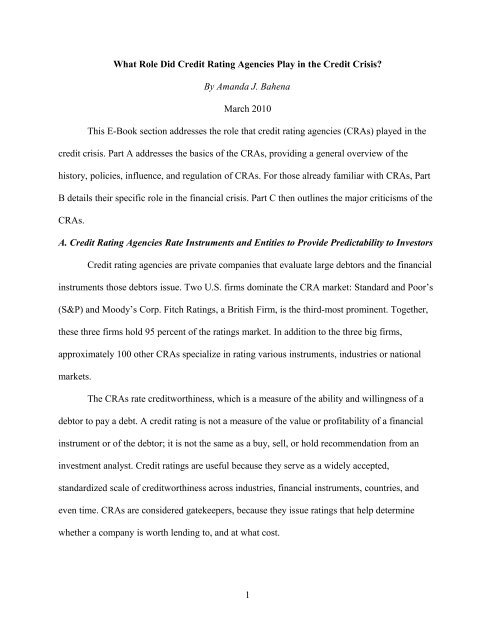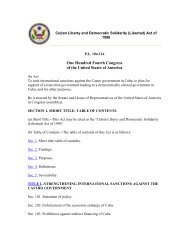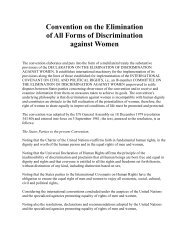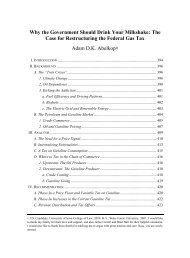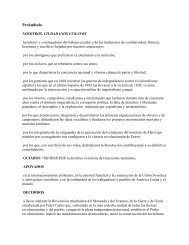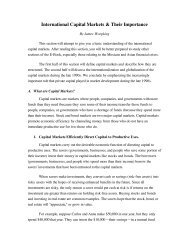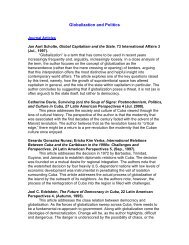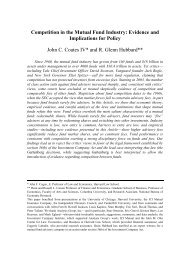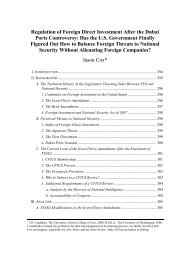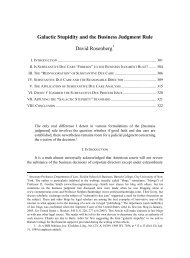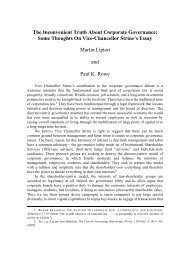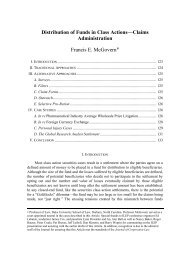What Role Did Credit Rating Agencies Play in the Credit Crisis? By ...
What Role Did Credit Rating Agencies Play in the Credit Crisis? By ...
What Role Did Credit Rating Agencies Play in the Credit Crisis? By ...
Create successful ePaper yourself
Turn your PDF publications into a flip-book with our unique Google optimized e-Paper software.
<strong>What</strong> <strong>Role</strong> <strong>Did</strong> <strong>Credit</strong> <strong>Rat<strong>in</strong>g</strong> <strong>Agencies</strong> <strong>Play</strong> <strong>in</strong> <strong>the</strong> <strong>Credit</strong> <strong>Crisis</strong>?<br />
<strong>By</strong> Amanda J. Bahena<br />
March 2010<br />
This E-Book section addresses <strong>the</strong> role that credit rat<strong>in</strong>g agencies (CRAs) played <strong>in</strong> <strong>the</strong><br />
credit crisis. Part A addresses <strong>the</strong> basics of <strong>the</strong> CRAs, provid<strong>in</strong>g a general overview of <strong>the</strong><br />
history, policies, <strong>in</strong>fluence, and regulation of CRAs. For those already familiar with CRAs, Part<br />
B details <strong>the</strong>ir specific role <strong>in</strong> <strong>the</strong> f<strong>in</strong>ancial crisis. Part C <strong>the</strong>n outl<strong>in</strong>es <strong>the</strong> major criticisms of <strong>the</strong><br />
CRAs.<br />
A. <strong>Credit</strong> <strong>Rat<strong>in</strong>g</strong> <strong>Agencies</strong> Rate Instruments and Entities to Provide Predictability to Investors<br />
<strong>Credit</strong> rat<strong>in</strong>g agencies are private companies that evaluate large debtors and <strong>the</strong> f<strong>in</strong>ancial<br />
<strong>in</strong>struments those debtors issue. Two U.S. firms dom<strong>in</strong>ate <strong>the</strong> CRA market: Standard and Poor’s<br />
(S&P) and Moody’s Corp. Fitch <strong>Rat<strong>in</strong>g</strong>s, a British Firm, is <strong>the</strong> third-most prom<strong>in</strong>ent. Toge<strong>the</strong>r,<br />
<strong>the</strong>se three firms hold 95 percent of <strong>the</strong> rat<strong>in</strong>gs market. In addition to <strong>the</strong> three big firms,<br />
approximately 100 o<strong>the</strong>r CRAs specialize <strong>in</strong> rat<strong>in</strong>g various <strong>in</strong>struments, <strong>in</strong>dustries or national<br />
markets.<br />
The CRAs rate creditworth<strong>in</strong>ess, which is a measure of <strong>the</strong> ability and will<strong>in</strong>gness of a<br />
debtor to pay a debt. A credit rat<strong>in</strong>g is not a measure of <strong>the</strong> value or profitability of a f<strong>in</strong>ancial<br />
<strong>in</strong>strument or of <strong>the</strong> debtor; it is not <strong>the</strong> same as a buy, sell, or hold recommendation from an<br />
<strong>in</strong>vestment analyst. <strong>Credit</strong> rat<strong>in</strong>gs are useful because <strong>the</strong>y serve as a widely accepted,<br />
standardized scale of creditworth<strong>in</strong>ess across <strong>in</strong>dustries, f<strong>in</strong>ancial <strong>in</strong>struments, countries, and<br />
even time. CRAs are considered gatekeepers, because <strong>the</strong>y issue rat<strong>in</strong>gs that help determ<strong>in</strong>e<br />
whe<strong>the</strong>r a company is worth lend<strong>in</strong>g to, and at what cost.<br />
1
Each CRA has its own rat<strong>in</strong>g scale. Moody’s and S&P use <strong>the</strong> two pr<strong>in</strong>cipal scales.<br />
Moody’s highest rat<strong>in</strong>g is AAA, and anyth<strong>in</strong>g between AAA and Baa3 is “<strong>in</strong>vestment grade.”<br />
S&P and Fitch share a scale, with AAA be<strong>in</strong>g <strong>the</strong> highest rat<strong>in</strong>g. <strong>Rat<strong>in</strong>g</strong>s between AAA and<br />
BBB are “<strong>in</strong>vestment grade.” <strong>Rat<strong>in</strong>g</strong>s below <strong>the</strong>se levels are considered “speculative,” a label<br />
that denotes a risky <strong>in</strong>vestment. The less risk a CRA perceives <strong>in</strong> an entity or <strong>the</strong> issu<strong>in</strong>g debtor,<br />
<strong>the</strong> higher <strong>the</strong> rat<strong>in</strong>g. Therefore, when compar<strong>in</strong>g f<strong>in</strong>ancial <strong>in</strong>struments promis<strong>in</strong>g <strong>the</strong> same<br />
yields, <strong>in</strong>vestors are more will<strong>in</strong>g to <strong>in</strong>vest <strong>in</strong> <strong>the</strong> higher-rated <strong>in</strong>strument. Certa<strong>in</strong> <strong>in</strong>stitutional<br />
<strong>in</strong>vestors, such as pension funds, are only permitted by law to <strong>in</strong>vest <strong>in</strong> “<strong>in</strong>vestment grade”<br />
<strong>in</strong>struments. A low-rated entity must provide <strong>in</strong>vestors with additional <strong>in</strong>centives, such as higher<br />
<strong>in</strong>terest rates, to conv<strong>in</strong>ce <strong>the</strong>m to <strong>in</strong>vest. In this way, rat<strong>in</strong>gs directly affect <strong>the</strong> cost of rais<strong>in</strong>g<br />
capital. For example, <strong>in</strong> 2004, S&P data showed that if an entity advanced from a category BBB<br />
to a category BB, its borrow<strong>in</strong>g costs were reduced by almost 50 percent.<br />
While each CRA has its own unique rat<strong>in</strong>g procedures, <strong>the</strong> general process is similar<br />
across most CRAs. A credit rat<strong>in</strong>g is based on both quantitative and qualitative values.<br />
Quantitative data may <strong>in</strong>clude (1) data from <strong>the</strong> issuer about its f<strong>in</strong>ancial position, especially data<br />
on cash flow relative to debt obligations, (2) data <strong>the</strong> agency ga<strong>the</strong>rs on <strong>the</strong> <strong>in</strong>dustry,<br />
competitors, and <strong>the</strong> overall economy, and (3) legal advice relat<strong>in</strong>g to an issuance. Qualitative<br />
data may <strong>in</strong>clude (1) data from <strong>the</strong> issuer about management, policy, bus<strong>in</strong>ess outlook, and<br />
account<strong>in</strong>g practices, and (2) data ga<strong>the</strong>red by <strong>the</strong> agency relat<strong>in</strong>g to competitive position,<br />
quality of management, long-term <strong>in</strong>dustry prospects, and economic environment. A rat<strong>in</strong>g is<br />
typically reached by a team of raters under <strong>the</strong> direction of a lead analyst. A debtor or f<strong>in</strong>ancial<br />
<strong>in</strong>strument to be rated is assigned to <strong>the</strong> analyst team that specializes <strong>in</strong> that debtor or<br />
<strong>in</strong>strument’s <strong>in</strong>dustry. Analysts beg<strong>in</strong> by collect<strong>in</strong>g <strong>in</strong>formation on <strong>the</strong> entity <strong>the</strong>y are rat<strong>in</strong>g. This<br />
2
usually <strong>in</strong>volves meet<strong>in</strong>g with <strong>the</strong> debtor’s management at <strong>the</strong> debtor’s place of bus<strong>in</strong>ess. Once<br />
both quantitative and qualitative data is collected, <strong>the</strong> analysts evaluate <strong>the</strong> data and decide how<br />
much weight to give to each factor <strong>in</strong> <strong>the</strong> analysis. The analysts present <strong>the</strong>ir weight<strong>in</strong>g proposals<br />
to <strong>the</strong> overall rat<strong>in</strong>g committee, which <strong>the</strong>n decides what rat<strong>in</strong>g <strong>the</strong> debtor or <strong>the</strong> f<strong>in</strong>ancial<br />
<strong>in</strong>strument will receive. Before publish<strong>in</strong>g <strong>the</strong> rat<strong>in</strong>g, <strong>the</strong> CRA <strong>in</strong>forms <strong>the</strong> debtor of <strong>the</strong> rat<strong>in</strong>g<br />
and <strong>the</strong> reasons beh<strong>in</strong>d <strong>the</strong> rat<strong>in</strong>g. If <strong>the</strong> debtor disagrees with <strong>the</strong> proposed rat<strong>in</strong>g, it may attempt<br />
to provide fur<strong>the</strong>r <strong>in</strong>formation to adjust <strong>the</strong> rat<strong>in</strong>g; however, such adjustments are rarely made.<br />
The vast majority of rat<strong>in</strong>gs are made available to <strong>the</strong> public free of charge on <strong>the</strong> CRAs’<br />
homepages. However, some rat<strong>in</strong>gs are only published if <strong>the</strong> debtor consents.<br />
If a rat<strong>in</strong>g is a “po<strong>in</strong>t <strong>in</strong> time rat<strong>in</strong>g,” <strong>the</strong> CRA’s <strong>in</strong>volvement <strong>in</strong> <strong>the</strong> rated entity<br />
term<strong>in</strong>ates once it publishes <strong>the</strong> rat<strong>in</strong>g. For most rat<strong>in</strong>gs, however, <strong>the</strong> CRA cont<strong>in</strong>ues to monitor<br />
<strong>the</strong> issuer and/or its securities on an ongo<strong>in</strong>g, less <strong>in</strong>tensive level and cont<strong>in</strong>ues to periodically<br />
meet with <strong>the</strong> issuer’s senior management. If <strong>the</strong> rat<strong>in</strong>g is subject to monitor<strong>in</strong>g after it is<br />
published, a rat<strong>in</strong>g surveillance team reviews and revises <strong>the</strong> rat<strong>in</strong>g if and when it is necessary.<br />
<strong>Rat<strong>in</strong>g</strong> reviews occur at least once a year.<br />
1. "<strong>Rat<strong>in</strong>g</strong>s Crises" Have Challenged <strong>the</strong> Influence of CRAs<br />
CRA expertise <strong>in</strong> creditworth<strong>in</strong>ess has become more valuable as <strong>the</strong> f<strong>in</strong>ancial market has<br />
grown <strong>in</strong> complexity with new actors and new <strong>in</strong>struments. Years ago, f<strong>in</strong>anc<strong>in</strong>g was done<br />
mostly through commercial banks. For example, a customer would go to a bank to obta<strong>in</strong> a home<br />
loan, and a banker would sit down with <strong>the</strong> customer to determ<strong>in</strong>e his or her creditworth<strong>in</strong>ess. If<br />
a bank decided that <strong>the</strong> customer was creditworthy, <strong>the</strong> bank would issue <strong>the</strong> mortgage. This is<br />
no longer <strong>the</strong> case. Today, most mortgages do not stay with <strong>the</strong> bank, but are sold to an issuer<br />
and pooled with o<strong>the</strong>r debt obligations <strong>in</strong> complex f<strong>in</strong>ancial <strong>in</strong>struments to be sold to <strong>in</strong>vestors.<br />
3
The ultimate holders of <strong>the</strong> mortgage never have <strong>the</strong> chance to meet <strong>the</strong> debtor to determ<strong>in</strong>e his<br />
or her creditworth<strong>in</strong>ess. Fur<strong>the</strong>rmore, <strong>the</strong>se <strong>in</strong>struments are generally very complex and conta<strong>in</strong><br />
bits and pieces of many loans. Most <strong>in</strong>dividual <strong>in</strong>vestors have nei<strong>the</strong>r <strong>the</strong> time nor <strong>the</strong> ability to<br />
<strong>in</strong>vestigate <strong>the</strong> creditworth<strong>in</strong>ess of <strong>the</strong> loans <strong>in</strong> <strong>the</strong>se <strong>in</strong>struments.<br />
Such complex conditions create uncerta<strong>in</strong>ty, and uncerta<strong>in</strong>ty is risky. Investors tend to be<br />
adverse to risk and expect to be compensated, usually <strong>in</strong> <strong>the</strong> form of higher returns on <strong>the</strong>ir<br />
<strong>in</strong>vestment, for tak<strong>in</strong>g on perceived risk. This is where CRAs offer <strong>the</strong>ir services. The CRAs<br />
evaluate <strong>the</strong> creditworth<strong>in</strong>ess of <strong>the</strong> f<strong>in</strong>ancial <strong>in</strong>struments and issue a credit rat<strong>in</strong>g that is<br />
published for public use. In this way, credit rat<strong>in</strong>gs improve market efficiency. Instead of<br />
thousands of <strong>in</strong>vestors perform<strong>in</strong>g repetitive analysis on <strong>the</strong> same <strong>in</strong>struments, <strong>the</strong> CRAs<br />
perform <strong>the</strong> job once and provide <strong>in</strong>formation to <strong>the</strong> <strong>in</strong>vestors for no charge. It is no surprise,<br />
<strong>the</strong>n, that <strong>in</strong>vestors rely heavily on <strong>the</strong> services of CRAs, which makes CRAs a central,<br />
imbedded feature of <strong>the</strong> f<strong>in</strong>ancial markets.<br />
The demand for, and <strong>the</strong>refore <strong>in</strong>fluence of, CRAs has traditionally been very strong <strong>in</strong><br />
<strong>the</strong> United States, where CRAs first emerged to <strong>in</strong>form East Coast <strong>in</strong>vestors of opportunities <strong>in</strong><br />
<strong>the</strong> “Wild West.” S<strong>in</strong>ce that time, CRA <strong>in</strong>fluence over <strong>in</strong>vestors <strong>in</strong> <strong>the</strong> United States has only<br />
grown. Investors and officials <strong>in</strong> o<strong>the</strong>r countries have been slower to accept CRA practices<br />
stemm<strong>in</strong>g from <strong>the</strong> United States. European countries, for example, have traditionally<br />
emphasized bank-oriented f<strong>in</strong>anc<strong>in</strong>g, which reduced <strong>the</strong> need for <strong>in</strong>termediaries like CRAs. Real<br />
demand for CRA services did not surface <strong>in</strong> Europe until <strong>the</strong> late 1980s. Yet CRA <strong>in</strong>fluence has<br />
been grow<strong>in</strong>g <strong>in</strong> Europe and <strong>the</strong> rest of <strong>the</strong> world s<strong>in</strong>ce that time, especially with <strong>the</strong> <strong>in</strong>creased<br />
<strong>in</strong>ternationalization of f<strong>in</strong>ance. <strong>Credit</strong> rat<strong>in</strong>gs standardize data from borrowers around <strong>the</strong> world<br />
4
to allow <strong>in</strong>vestors to compare <strong>the</strong> risk of <strong>in</strong>vestments <strong>in</strong> different countries on <strong>the</strong> same rat<strong>in</strong>g<br />
scale.<br />
CRAs have ga<strong>in</strong>ed fur<strong>the</strong>r <strong>in</strong>fluence over <strong>the</strong> f<strong>in</strong>ancial markets through governmental<br />
regulations that mandate <strong>the</strong> use of rat<strong>in</strong>gs and through private contract rat<strong>in</strong>g requirements.<br />
Governmental regulations <strong>in</strong>crease reliance on rat<strong>in</strong>gs by, among o<strong>the</strong>r th<strong>in</strong>gs, sett<strong>in</strong>g a<br />
permissible m<strong>in</strong>imum rat<strong>in</strong>g for certa<strong>in</strong> <strong>in</strong>vestments. In <strong>the</strong> United States, as of September 2008,<br />
at least forty-four regulations of <strong>the</strong> Securities and Exchange Commission (SEC) <strong>in</strong>corporate <strong>the</strong><br />
use of rat<strong>in</strong>gs. For example, <strong>the</strong> SEC limits money market funds to <strong>in</strong>vestments <strong>in</strong> <strong>the</strong> top two<br />
rat<strong>in</strong>gs categories. O<strong>the</strong>r countries, <strong>in</strong>clud<strong>in</strong>g Canada, Belgium, and Poland, require certa<strong>in</strong><br />
<strong>in</strong>vestors to obta<strong>in</strong> prior approval before purchas<strong>in</strong>g certa<strong>in</strong> low-rated <strong>in</strong>struments, and ban o<strong>the</strong>r<br />
<strong>in</strong>vestors from <strong>in</strong>vest<strong>in</strong>g <strong>in</strong> low-rated <strong>in</strong>vestments at all. In Italy, securities must be rated before<br />
<strong>the</strong>y can be offered to non-commercial <strong>in</strong>vestors.<br />
The New Basel Capital Accord, or Basel II, which was <strong>in</strong>troduced <strong>in</strong> 2004, fur<strong>the</strong>r<br />
solidifies <strong>the</strong> role of CRAs <strong>in</strong> <strong>the</strong> f<strong>in</strong>ancial markets. The Basel II framework has been or will<br />
likely be adopted by a majority of <strong>the</strong> world’s countries. The first of <strong>the</strong> three Basel II pillars is<br />
<strong>the</strong> most relevant to CRAs as it sets m<strong>in</strong>imum capital requirements for credit, market, and<br />
operational risks. To calculate <strong>the</strong>se risks, Basel II allows two approaches: <strong>the</strong> “standardized<br />
approach” and <strong>the</strong> “<strong>in</strong>ternal rat<strong>in</strong>gs based approach” (IRB). The standardized approach uses<br />
external rat<strong>in</strong>gs from “external credit assessment <strong>in</strong>stitutions,” which <strong>in</strong>clude CRAs. The IRB<br />
uses banks’ own <strong>in</strong>ternal rat<strong>in</strong>gs. If a f<strong>in</strong>ancial <strong>in</strong>stitution elects to use <strong>the</strong> standardized approach,<br />
Basel II allows <strong>the</strong> <strong>in</strong>stitution to rely on CRA rat<strong>in</strong>gs <strong>in</strong>stead of assess<strong>in</strong>g risks itself. Some large<br />
banks will elect <strong>the</strong> IRB option, but <strong>the</strong> vast majority of small- and medium-sized f<strong>in</strong>ancial<br />
5
<strong>in</strong>stitutions are expected to adopt <strong>the</strong> simpler standardized approach, especially <strong>in</strong> less-developed<br />
countries.<br />
Private contracts also often <strong>in</strong>volve credit rat<strong>in</strong>g clauses for a variety of purposes. The<br />
most common use of “rat<strong>in</strong>gs triggers” is to accelerate repayment of an outstand<strong>in</strong>g loan or<br />
require <strong>the</strong> debtor to post additional collateral if its credit rat<strong>in</strong>g falls below a certa<strong>in</strong> level.<br />
Debtors subject to “rat<strong>in</strong>gs triggers” are careful to meet CRA expectations regard<strong>in</strong>g capital<br />
ratios, f<strong>in</strong>ancial performance, etc. to avoid potentially disastrous downgrades.<br />
In <strong>the</strong> past, “rat<strong>in</strong>gs crises” have challenged <strong>the</strong> <strong>in</strong>fluence of CRAs. A rat<strong>in</strong>gs crisis stems<br />
from a general lack of confidence <strong>in</strong> <strong>the</strong> CRAs and <strong>the</strong>ir rat<strong>in</strong>gs. The Enron collapse <strong>in</strong> 2001<br />
shook <strong>in</strong>vestor and regulator confidence <strong>in</strong> CRAs. The CRAs failed to downgrade Enron from<br />
<strong>in</strong>vestment grade through <strong>the</strong> latter half of 2001, even though Enron’s credit and ability to pay its<br />
debts drastically deteriorated dur<strong>in</strong>g that time. When <strong>the</strong> CRAs f<strong>in</strong>ally downgraded Enron, <strong>the</strong><br />
firm was already <strong>in</strong> dire straits. The downgrade destroyed what rema<strong>in</strong>ed of Enron’s stock, and<br />
Enron filed for bankruptcy only four days later. Similarly, when Parmalat Group collapsed, many<br />
criticized <strong>the</strong> CRAs for fail<strong>in</strong>g to revoke <strong>the</strong> Group’s <strong>in</strong>vestment-grade status until it was far too<br />
late. Also, many blamed <strong>the</strong> CRAs for overlook<strong>in</strong>g red flags before <strong>the</strong> Mexican peso crisis <strong>in</strong><br />
<strong>the</strong> mid-1990s and <strong>the</strong> Asian f<strong>in</strong>ancial crisis <strong>in</strong> <strong>the</strong> late 1990s. After each of <strong>the</strong>se crises,<br />
confidence <strong>in</strong> CRA rat<strong>in</strong>gs was shaken and calls for CRA reform and <strong>in</strong>creased regulation were<br />
common. However, as <strong>in</strong>vestors calmed, <strong>the</strong> <strong>in</strong>fluence of <strong>the</strong> CRAs returned, and little changed<br />
<strong>in</strong> <strong>the</strong> way of legislation and regulation.<br />
2. The Oversight System Limits <strong>the</strong> Number of CRAs and Allows for Self-<br />
Regulation<br />
The CRAs are not affiliated with any government and are subject to very little regulatory<br />
oversight by government agencies. In most countries, <strong>in</strong>clud<strong>in</strong>g <strong>the</strong> United States, <strong>the</strong> m<strong>in</strong>imal<br />
6
CRA legislation that exists is designed to foster CRA competition and transparency. The <strong>the</strong>ory<br />
beh<strong>in</strong>d this type of legislation is that <strong>the</strong> market will function best if <strong>in</strong>vestors are <strong>in</strong>formed and<br />
able to choose between CRAs. One example of legislation designed to foster CRA competition is<br />
<strong>the</strong> U.S. <strong>Credit</strong> <strong>Rat<strong>in</strong>g</strong> Agency Reform Act of 2006, which empowered <strong>the</strong> SEC to oversee CRA<br />
practices. Despite SEC oversight, <strong>the</strong> CRAs are still exempted from most SEC disclosure rules,<br />
are not required to disclose confidential <strong>in</strong>formation that issuers provide <strong>the</strong> CRAs dur<strong>in</strong>g <strong>the</strong><br />
rat<strong>in</strong>gs process, and are exempt from most provisions of <strong>the</strong> Securities Act, which prohibits fraud<br />
<strong>in</strong> connection with <strong>the</strong> issuance of securities.<br />
The most common form of CRA regulation <strong>in</strong>volves registration of exist<strong>in</strong>g CRAs. In <strong>the</strong><br />
United States, <strong>the</strong> SEC recognizes CRAs through its “nationally recognized statistical rat<strong>in</strong>g<br />
organization” (NRSRO) designation. As CRA rat<strong>in</strong>gs have grown more <strong>in</strong>fluential outside <strong>the</strong><br />
United States, o<strong>the</strong>r countries have adopted CRA designations. However, a designation is very<br />
different from a license to operate. A CRA may operate without NRSRO or any o<strong>the</strong>r formal<br />
recognition status. Currently no country requires formal governmental recognition for a CRA to<br />
produce credit rat<strong>in</strong>gs.<br />
The United States is typical <strong>in</strong> its designation practices. S<strong>in</strong>ce 1975, <strong>the</strong> SEC’s NRSRO<br />
designation of a CRA has allowed U.S. banks to rely on that CRA’s rat<strong>in</strong>gs for purposes of<br />
compliance with certa<strong>in</strong> bank<strong>in</strong>g rules. These regulations have led to some problems, <strong>in</strong>clud<strong>in</strong>g<br />
possible overreliance by <strong>in</strong>vestors on <strong>the</strong> NRSROs. As SEC chairman Christopher Cox<br />
expla<strong>in</strong>ed, <strong>the</strong> agency's reference to rat<strong>in</strong>gs <strong>in</strong> its rules “may be contribut<strong>in</strong>g to an uncritical<br />
reliance on credit rat<strong>in</strong>gs as a substitute for <strong>in</strong>dependent evaluation.”<br />
Until <strong>the</strong> passage of <strong>the</strong> <strong>Credit</strong> <strong>Rat<strong>in</strong>g</strong> Agency Reform Act of 2006 ("<strong>the</strong> 2006 Act”), <strong>the</strong><br />
NRSRO requirements were “vague” and “arbitrary.” There was no formal application process for<br />
7
NRSRO status and <strong>the</strong> process was criticized as anticompetitive: prior to <strong>the</strong> 2006 Act, only five<br />
CRAs had qualified for NRSRO status. The NRSRO designation served as a major barrier to<br />
new CRAs. The 2006 Act made it easier for compet<strong>in</strong>g agencies to ga<strong>in</strong> NRSRO status, but <strong>the</strong><br />
Act did not change <strong>the</strong> underly<strong>in</strong>g CRA model. Those support<strong>in</strong>g <strong>the</strong> 2006 Act believed that a<br />
greater number of CRAs might improve accountability, affordability, <strong>in</strong>novation and <strong>the</strong> overall<br />
quality of rat<strong>in</strong>gs.<br />
The 2006 Act requires a CRA that registers as an NRSRO to disclose important<br />
<strong>in</strong>formation such as rat<strong>in</strong>gs performance, conflicts of <strong>in</strong>terest, and <strong>the</strong> procedures used <strong>in</strong><br />
determ<strong>in</strong><strong>in</strong>g rat<strong>in</strong>gs. The 2006 Act mandates that <strong>the</strong> SEC grant NRSRO registration to any CRA<br />
that applies and has been <strong>in</strong> <strong>the</strong> rat<strong>in</strong>g bus<strong>in</strong>ess at least three consecutive years before submitt<strong>in</strong>g<br />
its NRSRO application, unless <strong>the</strong> SEC f<strong>in</strong>ds that ‘‘<strong>the</strong> applicant does not have adequate<br />
f<strong>in</strong>ancial and managerial resources to consistently produce credit rat<strong>in</strong>gs with <strong>in</strong>tegrity and to<br />
materially comply with <strong>the</strong> [SEC prescribed] procedures and methodologies.’’ Currently, n<strong>in</strong>e<br />
CRAs carry <strong>the</strong> NRSRO status.<br />
The CRAs advocate for greater self-regulation based on a code of ethics. They argue that<br />
self-regulation is <strong>the</strong> best way to keep CRAs unbiased and flexible <strong>in</strong> <strong>the</strong> face of chang<strong>in</strong>g<br />
markets. The International Organization of Securities Commissions (IOSCO) has been active <strong>in</strong><br />
promot<strong>in</strong>g CRA self-regulation. In 2004, <strong>the</strong> IOSCO Technical Committee released its Code of<br />
Conduct Fundamentals for <strong>Credit</strong> <strong>Rat<strong>in</strong>g</strong> <strong>Agencies</strong>, which stressed <strong>the</strong> need to improve<br />
transparency and protect aga<strong>in</strong>st conflicts of <strong>in</strong>terest. Most of <strong>the</strong> CRAs have s<strong>in</strong>ce voluntarily<br />
adopted codes based on <strong>the</strong>se IOSCO provisions. Critics of self-regulation argue that CRA self-<br />
regulation has clearly failed, given past and current f<strong>in</strong>ancial crises. Reformers suggest that self-<br />
regulat<strong>in</strong>g CRAs have been lack<strong>in</strong>g <strong>in</strong> quality, reliability and <strong>in</strong>dependence, and <strong>the</strong>refore greater<br />
8
governmental regulatory action is necessary. EU <strong>in</strong>ternal market commissioner Charlie<br />
McCreevy called <strong>the</strong> code of conduct adopted by <strong>the</strong> CRAs a “toothless wonder,” because a<br />
CRA that fails to follow <strong>the</strong> code of conduct faces no significant negative consequences. EU<br />
M<strong>in</strong>isters suggested that CRA self-regulation through codes of conduct is no substitute for EU-<br />
wide registration and a “streng<strong>the</strong>ned oversight regime” to improve disclosure, help prevent<br />
conflicts of <strong>in</strong>terest, and reduce <strong>in</strong>vestor overreliance on rat<strong>in</strong>gs.<br />
B. CRAs Were Implicated <strong>in</strong> <strong>the</strong> Recent <strong>Credit</strong> <strong>Crisis</strong> Due to <strong>the</strong> Influence of Their<br />
<strong>Rat<strong>in</strong>g</strong>s of MBSs, CDOs, and F<strong>in</strong>ancial Institutions<br />
The volume of requests for rat<strong>in</strong>g structured f<strong>in</strong>ance products such as mortgage-backed<br />
securities (MBSs) and collateralized debt obligations (CDOs) <strong>in</strong>creased drastically between 2004<br />
and 2006, as did <strong>the</strong> complexity of <strong>the</strong> rated products. In h<strong>in</strong>dsight, it appears that <strong>the</strong> structured<br />
f<strong>in</strong>ance hype caused <strong>the</strong> CRAs to lose <strong>the</strong>ir grip on reality. Lehman Bro<strong>the</strong>rs had an A rat<strong>in</strong>g<br />
only a month before its collapse. Worst of all, <strong>the</strong> CRAs rated thousands of derivative securities<br />
backed by subprime mortgages as AAA. Not only did <strong>the</strong> CRAs fail to react to chang<strong>in</strong>g market<br />
conditions <strong>in</strong> time, but <strong>the</strong>y played a central role <strong>in</strong> creat<strong>in</strong>g those market conditions. The CRAs<br />
were criticized for worsen<strong>in</strong>g <strong>the</strong> credit crisis by overvalu<strong>in</strong>g complex mortgage-backed<br />
<strong>in</strong>struments, by underestimat<strong>in</strong>g <strong>the</strong> complexity of those <strong>in</strong>struments, and by be<strong>in</strong>g slow to<br />
downgrade <strong>the</strong>m when <strong>the</strong>ir creditworth<strong>in</strong>ess worsened. In addition to <strong>the</strong> CRAs’ faulty<br />
understand<strong>in</strong>g of <strong>the</strong> mortgage-backed <strong>in</strong>struments and <strong>the</strong>ir overoptimistic view of <strong>the</strong> hous<strong>in</strong>g<br />
market, <strong>the</strong> CRA weaknesses expla<strong>in</strong>ed <strong>in</strong> Section III—conflicts of <strong>in</strong>terest, lack of transparency,<br />
and lack of competition among rat<strong>in</strong>g agencies—contributed to <strong>the</strong> overvaluation of many<br />
mortgage-backed <strong>in</strong>struments prior to <strong>the</strong> credit crisis.<br />
In a U.S. House Committee on Oversight and Government Reform <strong>in</strong>vestigation,<br />
committee chairman Henry Waxman said his <strong>in</strong>vestigators uncovered documents show<strong>in</strong>g that<br />
9
CRA executives knew <strong>the</strong> subprime market was weak before it collapsed, yet failed to reflect this<br />
knowledge <strong>in</strong> <strong>the</strong>ir rat<strong>in</strong>gs. These documents <strong>in</strong>cluded an email from a Moody’s employee who<br />
wrote that some MBS rat<strong>in</strong>gs made it appear that Moody’s was ei<strong>the</strong>r “<strong>in</strong>competent at credit<br />
analysis” or that raters “sold [<strong>the</strong>ir] soul to <strong>the</strong> devil for revenue.” An email from an S&P<br />
employee read, “Let’s hope we are all wealthy and retired by <strong>the</strong> time this house of cards<br />
falters.” F<strong>in</strong>ally, many market participants placed too much reliance on rat<strong>in</strong>gs and failed to<br />
perform <strong>the</strong>ir own due diligence to determ<strong>in</strong>e <strong>the</strong> strength of <strong>the</strong> new <strong>in</strong>struments. Perhaps<br />
<strong>in</strong>vestors would have discovered sooner <strong>the</strong> fragility of some of <strong>the</strong> overrated <strong>in</strong>struments and<br />
issuers had fewer <strong>in</strong>vestors bl<strong>in</strong>dly relied on <strong>the</strong> CRA rat<strong>in</strong>gs. This Part outl<strong>in</strong>es <strong>the</strong> role of<br />
CRAs <strong>in</strong> securitization and how that role helped lead to <strong>the</strong> global f<strong>in</strong>ancial crisis, how <strong>the</strong> CRAs<br />
reacted to <strong>the</strong> subsequent meltdown, and how <strong>in</strong>vestor overreliance on rat<strong>in</strong>gs fur<strong>the</strong>red market<br />
failures.<br />
1. CRAs Rated MBSs and CDOs Highly Despite Limited Information, Build<strong>in</strong>g<br />
Investor Confidence <strong>in</strong> <strong>the</strong> Instruments Prior to <strong>the</strong> <strong>Crisis</strong><br />
A central problem lead<strong>in</strong>g up to <strong>the</strong> global f<strong>in</strong>ancial crisis was that CRAs rated billions of<br />
dollars of structured f<strong>in</strong>ance <strong>in</strong>struments too highly. Structured f<strong>in</strong>ance is a f<strong>in</strong>anc<strong>in</strong>g technique<br />
where f<strong>in</strong>ancial <strong>in</strong>stitutions pool numerous obligations toge<strong>the</strong>r and sell <strong>the</strong> <strong>in</strong>terests <strong>in</strong> <strong>the</strong> pool<br />
to <strong>in</strong>vestors. The structured f<strong>in</strong>ance <strong>in</strong>struments at <strong>the</strong> heart of <strong>the</strong> current credit crisis are<br />
mortgage-backed securities (MBSs) and collateralized debt obligations (CDOs). These<br />
<strong>in</strong>struments are more complex than most of <strong>the</strong> traditional bonds and securities that CRAs have<br />
been rat<strong>in</strong>g for more than 100 years. CRAs have been criticized for not fully understand<strong>in</strong>g <strong>the</strong><br />
risks and complexity of <strong>the</strong> MBSs and CDOs that <strong>the</strong>y rated.<br />
The CRAs had a central role <strong>in</strong> <strong>the</strong> development of <strong>the</strong>se complex <strong>in</strong>struments. Lenders<br />
wanted to sell risky subprime mortgages that <strong>the</strong>y had orig<strong>in</strong>ated to remove <strong>the</strong> assets from <strong>the</strong>ir<br />
10
alance sheets and free up capital for new loans. In this way, <strong>the</strong> lenders could avoid <strong>the</strong> risk of<br />
hold<strong>in</strong>g <strong>the</strong> mortgage and also collect more loan fees from <strong>the</strong> new loans. This is where <strong>the</strong> MBS<br />
became useful. The MBS could turn low-rated securities, such as subprime mortgages, <strong>in</strong>to<br />
AAA-rated securities. Recall that regulations and <strong>in</strong>ternal criteria prevent many <strong>in</strong>stitutional<br />
<strong>in</strong>vestors, such as money market funds, from hold<strong>in</strong>g low-rated securities. The “magical”<br />
transformation of subprime mortgages from junk to AAA allowed <strong>the</strong>se regulated <strong>in</strong>vestors to<br />
enter <strong>the</strong> subprime mortgage market, which was very profitable at that time.<br />
Governmental, quasi-governmental, or private entities create MBAs by purchas<strong>in</strong>g<br />
mortgage loans from banks, mortgage companies, and o<strong>the</strong>r orig<strong>in</strong>ators and <strong>the</strong>n assembl<strong>in</strong>g <strong>the</strong><br />
mortgages <strong>in</strong>to pools, called “collateral pools.” Fannie Mae and Freddie Mac, which are U.S.<br />
government-sponsored entities, and banks issued most MBSs. The top bank issuers <strong>in</strong> 2007 were<br />
Countrywide, J.P. Morgan, GMAC, Lehman Bros., and Citigroup. MBS issuers <strong>in</strong>corporate <strong>the</strong><br />
mortgages <strong>in</strong>to a special-purpose vehicle (SPV), which is a corporation with no people or assets<br />
aside from <strong>the</strong> mortgages it holds. The mortgages <strong>in</strong> <strong>the</strong> SPV are comb<strong>in</strong>ed and re-divided <strong>in</strong>to<br />
several senior/junior component parts, or “tranches.” A conventional MBS uses a three-tier<br />
design with junior, mezzan<strong>in</strong>e, and senior tranches. Each tranche <strong>the</strong>n issues tradable, <strong>in</strong>terest-<br />
bear<strong>in</strong>g securities that are sold to capital market <strong>in</strong>vestors.<br />
The purpose of tranch<strong>in</strong>g is to create at least one class of assets with a higher credit rat<strong>in</strong>g<br />
than <strong>the</strong> average rat<strong>in</strong>g of an MBS’s underly<strong>in</strong>g asset pool. CRAs rate each tranche based on <strong>the</strong><br />
creditworth<strong>in</strong>ess of <strong>the</strong> loans <strong>in</strong> that tranche and <strong>the</strong> tranche’s enhancements, such as<br />
prioritization and any <strong>in</strong>surance on payments. Tranches get higher credit rat<strong>in</strong>gs primarily by<br />
hav<strong>in</strong>g a higher priority: issuers guarantee “senior” tranches will be paid before “junior” or<br />
“mezzan<strong>in</strong>e” tranches. Senior tranches receive high rat<strong>in</strong>gs while junior tranches have low credit<br />
11
at<strong>in</strong>gs. The equity tranche, <strong>the</strong> most junior tranche, is paid last and normally constitutes around<br />
2 percent of <strong>the</strong> MBS. The senior tranches typically make up 80 percent of <strong>the</strong> MBS and, until<br />
<strong>the</strong> hous<strong>in</strong>g market collapsed, normally carried AAA rat<strong>in</strong>gs. Low-risk <strong>in</strong>vestors prefer senior<br />
tranches, <strong>the</strong> mezzan<strong>in</strong>e level appeals to <strong>in</strong>vestors seek<strong>in</strong>g a bit more return <strong>in</strong> exchange for a<br />
riskier security, and <strong>the</strong> equity tranches are <strong>in</strong>tended for <strong>in</strong>vestors such as hedge funds look<strong>in</strong>g<br />
for high returns despite <strong>the</strong> risks <strong>in</strong>volved.<br />
CRAs advised MBS issuers on how to structure and prioritize <strong>the</strong> tranches of an MBS.<br />
The goal was to help issuers squeeze <strong>the</strong> maximum profit from an MBS by maximiz<strong>in</strong>g <strong>the</strong> size<br />
of its highest rated tranches. The mezzan<strong>in</strong>e tranches, however, presented a problem—<strong>the</strong>y made<br />
up a significant portion of MBSs, but were too risky for most <strong>in</strong>stitutional <strong>in</strong>vestors. Around<br />
2003, <strong>the</strong> CDO came to <strong>the</strong> “rescue” to solve this problem and generate still more bus<strong>in</strong>ess for<br />
<strong>the</strong> thriv<strong>in</strong>g CRAs.<br />
A CDO is even far<strong>the</strong>r removed than an MBS from <strong>the</strong> orig<strong>in</strong>al mortgages it holds.<br />
Ra<strong>the</strong>r than buy<strong>in</strong>g mortgages, like MBSs do, <strong>the</strong> SPVs that issue CDOs buys MBSs. Many<br />
MBS mezzan<strong>in</strong>e tranches were <strong>in</strong>corporated <strong>in</strong>to CDO collateral pools along with o<strong>the</strong>r types of<br />
assets. Like mutual funds, CDOs buy and sell mortgage bonds throughout <strong>the</strong>ir existence.<br />
Therefore <strong>the</strong> collateral pool of a s<strong>in</strong>gle CDO can constantly change. CDOs are also divided <strong>in</strong>to<br />
senior, mezzan<strong>in</strong>e, and junior tranches. Before <strong>the</strong> crisis struck, CRAs rated <strong>the</strong> vast majority of<br />
CDOs as AAA, despite be<strong>in</strong>g backed by some of <strong>the</strong> riskiest pieces of <strong>the</strong> MBSs. Aga<strong>in</strong>, <strong>the</strong> key<br />
was prioritiz<strong>in</strong>g and <strong>in</strong>sur<strong>in</strong>g <strong>the</strong> CDO tranches. Also, as with <strong>the</strong> MBSs, <strong>the</strong> CRAs worked<br />
closely with CDO issuers to help <strong>the</strong>m obta<strong>in</strong> <strong>the</strong> highest rat<strong>in</strong>gs for <strong>the</strong> largest percentage of<br />
CDOs possible. CDOs are issued primarily by large banks. Top CDO issuers <strong>in</strong> 2007 were<br />
Merrill Lynch, Citibank, and UBS. The CDO market grew at an <strong>in</strong>credible pace: from $150<br />
12
illion <strong>in</strong> 2000 to $1.2 trillion <strong>in</strong> 2007. CDOs got so popular that issuers even created CDOs<br />
conta<strong>in</strong><strong>in</strong>g tranches of o<strong>the</strong>r CDOs (called “CDOs-squared”) and CDOs of CDOs of CDOs<br />
(called “CDOs-cubed”)!<br />
Many <strong>in</strong>vestors did not fully understand <strong>the</strong>se MBSs and CDOs, and CRAs played a<br />
central role <strong>in</strong> build<strong>in</strong>g <strong>in</strong>vestor confidence <strong>in</strong> <strong>the</strong>se <strong>in</strong>struments. Because <strong>the</strong>se <strong>in</strong>struments were<br />
able to <strong>in</strong>corporate subprime mortgages, which carried higher <strong>in</strong>terest rates than standard<br />
mortgages, <strong>the</strong>y were able to promise higher returns to <strong>in</strong>vestors. Never m<strong>in</strong>d that a significant<br />
percentage of <strong>the</strong> mortgages would default—<strong>the</strong> mortgages were backed by houses <strong>in</strong> a market<br />
where hous<strong>in</strong>g values always seemed to go up, and at <strong>the</strong> time <strong>the</strong> land back<strong>in</strong>g a mortgage was<br />
usually worth more than <strong>the</strong> mortgage. That is why most tranches <strong>in</strong> a typical MBS or CDO were<br />
rated AAA. These MBSs and CDOs promised higher returns than many traditional f<strong>in</strong>ancial<br />
<strong>in</strong>struments, and many were rated as highly as <strong>the</strong> traditional <strong>in</strong>struments. Investors were<br />
hooked.<br />
In reality, <strong>the</strong> CRAs did not look at <strong>the</strong> <strong>in</strong>dividual creditworth<strong>in</strong>ess of <strong>the</strong> mortgagors. In<br />
<strong>the</strong> words of one veteran Moody’s analyst, credit analysts are not “loan officers,” but ra<strong>the</strong>r<br />
statisticians. The CRAs usually did not even have access to <strong>in</strong>dividual loan files. The CRAs rated<br />
<strong>the</strong> creditworth<strong>in</strong>ess of <strong>the</strong>se <strong>in</strong>struments by referr<strong>in</strong>g to statistics based on historical data<br />
show<strong>in</strong>g how many people with shared characteristics, such as <strong>in</strong>come and geography, typically<br />
pay <strong>the</strong>ir mortgages. The situation for CDOs was worse—CDOs were rated by CRAs that had no<br />
idea what MBSs or o<strong>the</strong>r securities <strong>the</strong> CDO pool would purchase.<br />
2. When <strong>the</strong> Hous<strong>in</strong>g Market Collapsed, CRAs Quickly and Drastically Downgraded<br />
MBSs and CDOs<br />
13
It is clear that CRAs held an overoptimistic view of <strong>the</strong> hous<strong>in</strong>g market and <strong>the</strong> default<br />
rates for subprime mortgages. They failed to consider <strong>the</strong> real consequences and probability of a<br />
major hous<strong>in</strong>g market downturn. While one house might be able to be sold to redeem its<br />
mortgage, <strong>the</strong> market will not allow one million houses to be sold to redeem all <strong>the</strong>ir mortgages.<br />
As one Moody’s executive expla<strong>in</strong>ed, “Fitch and S&P went nuts. Everyth<strong>in</strong>g was <strong>in</strong>vestment<br />
grade . . . The mach<strong>in</strong>e just kept go<strong>in</strong>g.” S&P executives later admitted that many of <strong>the</strong><br />
assumptions underly<strong>in</strong>g mortgage-related rat<strong>in</strong>gs from 2005 to 2007 were erroneous. Even as <strong>the</strong><br />
subprime market began to unravel <strong>in</strong> <strong>the</strong> United States dur<strong>in</strong>g 2007, many of <strong>the</strong> MBSs<br />
cont<strong>in</strong>ued to receive or ma<strong>in</strong>ta<strong>in</strong> AAA rat<strong>in</strong>gs. As <strong>the</strong> hous<strong>in</strong>g market worsened and many<br />
mortgages went <strong>in</strong>to default, <strong>in</strong>vestors questioned <strong>the</strong> validity of <strong>the</strong> AAA rat<strong>in</strong>gs. In April 2007,<br />
S&P announced that it was adjust<strong>in</strong>g <strong>the</strong> method of rat<strong>in</strong>g subprime mortgages and <strong>the</strong><br />
<strong>in</strong>struments <strong>in</strong>corporat<strong>in</strong>g <strong>the</strong>m. They admitted that <strong>the</strong> previous model, which was <strong>in</strong>troduced <strong>in</strong><br />
2002, did not fit <strong>the</strong> current hous<strong>in</strong>g market. This confirmed <strong>in</strong>vestor concerns that CRAs had<br />
failed to consider <strong>the</strong> possibility of a hous<strong>in</strong>g market downturn and its effects on subprime<br />
mortgages.<br />
CDOs held many more subprime mortgages than MBSs did, and when <strong>the</strong> U.S. subprime<br />
mortgage market collapsed, CDOs were hit harder than <strong>the</strong> MBSs. However, CRAs had rated<br />
MBSs and CDOs similarly up to that po<strong>in</strong>t, which caused <strong>in</strong>vestors to view MBSs with nearly as<br />
much suspicion as CDOs. This general suspicion caused <strong>in</strong>vestors to flee from CDOs and MBSs<br />
alike, which caused <strong>the</strong> value of both <strong>in</strong>struments to drop and worsened <strong>the</strong> credit crisis.<br />
Investors suddenly viewed all real-estate backed <strong>in</strong>struments as toxic and refused to cont<strong>in</strong>ue<br />
purchas<strong>in</strong>g those <strong>in</strong>struments. Lenders were unexpectedly stuck with billions of dollars <strong>in</strong><br />
mortgage-related assets on <strong>the</strong>ir books—assets <strong>the</strong>y had expected to sell. The value of <strong>the</strong>se<br />
14
assets was deteriorat<strong>in</strong>g and lenders stuck with <strong>the</strong>se assets found <strong>the</strong>mselves with too little<br />
capital to cont<strong>in</strong>ue lend<strong>in</strong>g.<br />
As <strong>the</strong> hous<strong>in</strong>g market worsened and foreclosures <strong>in</strong>creased dur<strong>in</strong>g <strong>the</strong> summer and fall<br />
of 2007, <strong>the</strong> CRAs downgraded billions of dollars of MBSs and CDOs. Many formerly AAA-<br />
rated securities were downgraded five levels to a speculative grade, o<strong>the</strong>rwise known as “junk.”<br />
In <strong>the</strong> third quarter of 2007, CRAs downgraded $85 billion <strong>in</strong> mortgage securities. In <strong>the</strong> fourth<br />
quarter alone, $237 billion <strong>in</strong> MBSs were downgraded. In <strong>the</strong> first quarter of 2008, an additional<br />
$739 billion <strong>in</strong> MBSs were downgraded, and $841 billion were downgraded <strong>in</strong> <strong>the</strong> second<br />
quarter of 2008. That amounts to nearly $2 trillion <strong>in</strong> downgrades <strong>in</strong> those four quarters alone.<br />
Insurers of MBSs and CDOs found <strong>the</strong>mselves with <strong>in</strong>sufficient capital to meet all <strong>the</strong> claims<br />
from <strong>the</strong> fail<strong>in</strong>g <strong>in</strong>struments. Many MBS and CDO holders found <strong>the</strong>ir once valuable assets to be<br />
worthless.<br />
The largest holders of CDOs and MBSs bore <strong>the</strong> brunt of <strong>the</strong> <strong>in</strong>itial blow. As of mid-<br />
2008, foreign <strong>in</strong>vestors held 20 percent of <strong>the</strong> MBSs, while Fannie Mae and Freddie Mac held16<br />
percent, and commercial banks held16 percent. Key CDO <strong>in</strong>vestors <strong>in</strong>cluded banks, <strong>in</strong>surance<br />
companies, pension funds, and hedge funds. Downgrades caused major problems for banks<br />
hold<strong>in</strong>g CDOs and MBSs because <strong>the</strong>ir capital ratios were adversely affected. If <strong>the</strong> banks failed<br />
to improve <strong>the</strong>ir capital ratios, <strong>the</strong> CRAs threatened <strong>the</strong> banks <strong>the</strong>mselves with rat<strong>in</strong>g<br />
downgrades. The collapse of <strong>the</strong> <strong>in</strong>vestment bank Lehman Bro<strong>the</strong>rs is a drastic example. Lehman<br />
Bro<strong>the</strong>rs was look<strong>in</strong>g for a buyer <strong>in</strong> September 2008 and it had a lot at stake. Given <strong>the</strong> massive<br />
amounts of CDOs and MBSs <strong>in</strong> Lehman Bro<strong>the</strong>rs' portfolio, <strong>the</strong> CRAs said <strong>the</strong>y would be forced<br />
to cut <strong>the</strong> bank’s rat<strong>in</strong>gs if it failed to f<strong>in</strong>d a buyer. A rat<strong>in</strong>gs downgrade would have made it<br />
almost impossible for Lehman Bro<strong>the</strong>rs to raise enough capital to stay afloat. Only days after <strong>the</strong><br />
15
CRA ultimatum, Lehman Bro<strong>the</strong>rs filed for bankruptcy due to its <strong>in</strong>ability to raise capital or f<strong>in</strong>d<br />
a buyer. Banks were not <strong>the</strong> only <strong>in</strong>stitutions affected by rat<strong>in</strong>gs downgrades. The liquidity crisis<br />
of AIG, a major American <strong>in</strong>surance firm, was <strong>in</strong>tensified by a str<strong>in</strong>g of rat<strong>in</strong>gs downgrades <strong>in</strong><br />
mid-September. The U.S. government stepped <strong>in</strong> to rescue <strong>the</strong> ail<strong>in</strong>g firm soon afterward. One of<br />
<strong>the</strong> primary reasons AIG and o<strong>the</strong>r <strong>in</strong>surance companies were downgraded was due to <strong>the</strong>ir<br />
hold<strong>in</strong>gs <strong>in</strong> derivatives that <strong>the</strong> CRAs had once rated as safe <strong>in</strong>vestments. The National<br />
Association of Insurance Commissioners (NAIC) criticized <strong>the</strong> CRAs for <strong>the</strong>ir role <strong>in</strong><br />
downgrad<strong>in</strong>g <strong>in</strong>surance companies for hold<strong>in</strong>g <strong>in</strong>vestments that <strong>the</strong> same CRAs once rated as<br />
safe to own.<br />
Many of <strong>the</strong> recent major downgrades on f<strong>in</strong>ancial <strong>in</strong>stitutions and securities were<br />
drastic. Ra<strong>the</strong>r than slowly decreas<strong>in</strong>g a rat<strong>in</strong>g as <strong>the</strong> markets changed, CRAs deeply and<br />
suddenly downgraded <strong>the</strong> rat<strong>in</strong>gs, which caused panic among <strong>in</strong>vestors. There was little or no<br />
communication from <strong>the</strong> CRAs lead<strong>in</strong>g up to a downgrade, which <strong>in</strong>creased <strong>in</strong>vestor uncerta<strong>in</strong>ty<br />
as to which entities or <strong>in</strong>vestments would be downgraded next. It has been suggested that if<br />
CRAs had better monitored <strong>the</strong>se <strong>in</strong>vestments and entities, such drastic, sudden downgrades<br />
would not have been necessary. Fewer drastic downgrades may have provided <strong>in</strong>vestors with<br />
more time to adjust <strong>the</strong>ir <strong>in</strong>vestment strategies and avoided <strong>the</strong> panic caused by a sudden steep<br />
downgrade.<br />
In light of all <strong>the</strong> drastic downgrades <strong>the</strong> confidence of most market participants, both <strong>in</strong><br />
<strong>the</strong> United States and abroad, quickly waned. Private <strong>in</strong>vestors and <strong>in</strong>stitutions hold<strong>in</strong>g CDOs<br />
criticized <strong>the</strong> fact that CRAs gave AAA status to many CDOs that, <strong>in</strong> h<strong>in</strong>dsight, were clearly<br />
backed by risky securities. Institutions hold<strong>in</strong>g <strong>the</strong>se <strong>in</strong>struments that CRAs had once rated as<br />
safe suddenly were punished by downgrades <strong>the</strong>mselves as <strong>the</strong>y found it impossible to rid<br />
16
<strong>the</strong>mselves of <strong>the</strong> toxic assets. In general, <strong>in</strong>vestors argued that <strong>the</strong> AAA-rated CDOs made a<br />
“mockery” of <strong>the</strong> AAA rat<strong>in</strong>g, which left all <strong>in</strong>vestors question<strong>in</strong>g even <strong>the</strong> safest of AAA<br />
<strong>in</strong>vestments and caused <strong>in</strong>vestors to flee from anyth<strong>in</strong>g rated less than AAA. The failure of<br />
AAA-rated <strong>in</strong>struments was a major shock given <strong>the</strong> traditional reliability of <strong>the</strong> rat<strong>in</strong>g: between<br />
1970 and <strong>the</strong> current crisis, Moody’s had never downgraded an AAA-rated corporate bond to<br />
lower than A. Suddenly, an AAA-rated <strong>in</strong>strument had become susceptible to failure. This loss<br />
of faith <strong>in</strong> rat<strong>in</strong>gs played a large role <strong>in</strong> freez<strong>in</strong>g <strong>the</strong> f<strong>in</strong>ancial markets.<br />
3. Investors Relied Too Heavily on <strong>Rat<strong>in</strong>g</strong>s, Ra<strong>the</strong>r Than Perform<strong>in</strong>g Due Diligence<br />
The CRAs should not be forced to shoulder all <strong>the</strong> blame for <strong>the</strong> current rat<strong>in</strong>gs crisis.<br />
Even though CRA rat<strong>in</strong>gs are not <strong>in</strong>tended to be used as buy, sell, or hold recommendations,<br />
many <strong>in</strong>vestors use <strong>the</strong>m as such. These <strong>in</strong>vestors failed to adequately perform <strong>the</strong>ir own due<br />
diligence and often did not look beyond <strong>the</strong> rat<strong>in</strong>g. Many <strong>in</strong>vestors did not even read <strong>the</strong> rat<strong>in</strong>g<br />
rationale and disclosure documents that <strong>the</strong> CRAs publish for each rat<strong>in</strong>g. Instead, <strong>the</strong>y relied<br />
exclusively on <strong>the</strong> published rat<strong>in</strong>g and on <strong>the</strong> ongo<strong>in</strong>g market excitement surround<strong>in</strong>g MBSs<br />
and CDOs.<br />
Fur<strong>the</strong>rmore, many <strong>in</strong>vestors treated credit rat<strong>in</strong>gs as an absolute truth. These <strong>in</strong>vestors<br />
treated rat<strong>in</strong>g agencies as hav<strong>in</strong>g unlimited access to corporate <strong>in</strong>formation <strong>in</strong> calculat<strong>in</strong>g <strong>the</strong><br />
company’s credit rat<strong>in</strong>g, much like an auditor would. However, <strong>in</strong> rat<strong>in</strong>g an MBS, for example, a<br />
CRA does not see <strong>in</strong>dividual loan files or <strong>in</strong>formation identify<strong>in</strong>g borrowers or specific<br />
properties. The CRA only receives a list of credit characteristics provided by <strong>the</strong> banks issu<strong>in</strong>g<br />
<strong>the</strong> orig<strong>in</strong>al mortgages or <strong>the</strong> <strong>in</strong>vestment bank issu<strong>in</strong>g <strong>the</strong> MBS. If a CRA receives <strong>in</strong>complete or<br />
<strong>in</strong>accurate <strong>in</strong>formation about <strong>the</strong> entity it is rat<strong>in</strong>g, <strong>the</strong> rat<strong>in</strong>g will also be <strong>in</strong>complete and<br />
<strong>in</strong>accurate. A rat<strong>in</strong>g is only as accurate as <strong>the</strong> <strong>in</strong>formation that goes <strong>in</strong>to its calculation.<br />
17
C. CRAs Have Been Criticized for Conflicts of Interest, <strong>the</strong> Dom<strong>in</strong>ance of <strong>the</strong> Industry by U.S.<br />
Firms, and a Lack of Transparency<br />
As expla<strong>in</strong>ed earlier, this was not <strong>the</strong> first rat<strong>in</strong>gs crisis. However, it may be <strong>the</strong> broadest<br />
<strong>in</strong> scope. S<strong>in</strong>ce <strong>the</strong> downturn, many, <strong>in</strong>clud<strong>in</strong>g <strong>the</strong> SEC and o<strong>the</strong>r U.S. government agencies,<br />
have criticized CRA practices. In August 2007, <strong>the</strong> SEC conducted an <strong>in</strong>tensive <strong>in</strong>vestigation of<br />
<strong>the</strong> practices and performance of <strong>the</strong> top three CRAs. The SEC issued its f<strong>in</strong>d<strong>in</strong>gs <strong>in</strong> July 2008.<br />
The SEC found that <strong>the</strong>re was a substantial <strong>in</strong>crease <strong>in</strong> <strong>the</strong> number and <strong>in</strong> <strong>the</strong> complexity of MBS<br />
and CDO deals s<strong>in</strong>ce 2002, and that some of <strong>the</strong> rat<strong>in</strong>g agencies appear to have struggled with<br />
this growth. This Part outl<strong>in</strong>es <strong>the</strong> major criticisms of CRA practices, <strong>in</strong>clud<strong>in</strong>g conflicts of<br />
<strong>in</strong>terest, U.S. firms’ dom<strong>in</strong>ation of <strong>the</strong> <strong>in</strong>dustry, and a lack of transparency.<br />
A major criticism of <strong>the</strong> CRAs is that <strong>the</strong>y face irreconcilable conflicts of <strong>in</strong>terest given<br />
<strong>the</strong> close relationship many CRAs have with <strong>the</strong> banks issu<strong>in</strong>g <strong>the</strong> securities that <strong>the</strong> CRAs rate.<br />
Pr<strong>in</strong>cipally, most rat<strong>in</strong>gs are solicited and paid for by <strong>the</strong> entity be<strong>in</strong>g rated: <strong>the</strong> issuer. In <strong>the</strong><br />
early days of CRAs, issuers did not pay for <strong>the</strong> rat<strong>in</strong>gs. When a rat<strong>in</strong>g is unsolicited, it is easy to<br />
see that <strong>the</strong> CRA’s f<strong>in</strong>al customers are members of <strong>the</strong> public. However, when a rat<strong>in</strong>g is<br />
solicited, it is less clear whe<strong>the</strong>r <strong>the</strong> CRAs ultimately serve <strong>the</strong> <strong>in</strong>vest<strong>in</strong>g public or <strong>the</strong> rated,<br />
pay<strong>in</strong>g entity. Large CRAs receive most of <strong>the</strong>ir revenue from fees paid by issuers, and issuer-<br />
paid rat<strong>in</strong>gs represent 98 percent of rat<strong>in</strong>gs produced. After an <strong>in</strong>strument is rated, <strong>the</strong> issuer can<br />
decide whe<strong>the</strong>r or not that rat<strong>in</strong>g will be published, or “issued,” and CRAs are only paid if <strong>the</strong><br />
rat<strong>in</strong>g is <strong>in</strong> fact issued. Issuers are not afraid to engage <strong>in</strong> “rat<strong>in</strong>gs shopp<strong>in</strong>g.” For example, an<br />
<strong>in</strong>vestment bank that receives a better rat<strong>in</strong>g from one CRA than ano<strong>the</strong>r will likely return to <strong>the</strong><br />
higher-rat<strong>in</strong>g CRA <strong>the</strong> next time it issues a similar <strong>in</strong>strument. The ma<strong>in</strong> concern surrounds<br />
frequent issuers, whose fees make up a significant portion of CRA's profits. A few f<strong>in</strong>ancial<br />
<strong>in</strong>stitutions conduct most CDO and MBS deals. Therefore, a CRA will be tempted to provide<br />
18
anks with high rat<strong>in</strong>gs <strong>in</strong> hopes that <strong>the</strong> “client” will return with more rat<strong>in</strong>g bus<strong>in</strong>ess. One<br />
senior executive at Moody’s warned <strong>the</strong> Moody’s board of directors that issuers of MBSs<br />
awarded bus<strong>in</strong>ess to <strong>the</strong> CRAs that produced <strong>in</strong>flated rat<strong>in</strong>gs.<br />
Additionally, CRAs have begun provid<strong>in</strong>g advice for a fee to companies look<strong>in</strong>g to<br />
improve <strong>the</strong>ir rat<strong>in</strong>gs. This creates additional conflicts of <strong>in</strong>terest. For example, if a company<br />
follows <strong>the</strong> CRA’s advice, <strong>the</strong> CRA may be tempted to issue <strong>the</strong> company a higher rat<strong>in</strong>g. Such<br />
practices would make CRA advice very valuable to companies look<strong>in</strong>g to improve <strong>the</strong>ir rat<strong>in</strong>gs.<br />
CRAs attempt to avoid this conflict of <strong>in</strong>terest by rat<strong>in</strong>g <strong>in</strong> teams and by separat<strong>in</strong>g <strong>the</strong>ir rat<strong>in</strong>g<br />
divisions from <strong>the</strong>ir advis<strong>in</strong>g divisions. The 2007 SEC study found “serious shortcom<strong>in</strong>gs”<br />
regard<strong>in</strong>g CRAs' attempts to manage both <strong>the</strong>se types of conflicts of <strong>in</strong>terest.<br />
An additional concern is that <strong>the</strong> U.S. firms’ dom<strong>in</strong>ance of <strong>the</strong> CRA market forces rated<br />
bus<strong>in</strong>esses and governments worldwide to conform to U.S. bus<strong>in</strong>ess ideals <strong>in</strong> order to achieve<br />
high rat<strong>in</strong>gs. U.S. CRAs argue that <strong>the</strong>ir evaluation approaches are free from <strong>in</strong>fluences based on<br />
<strong>the</strong> location and legal system of <strong>the</strong> rated entity. However, some governments, such as Germany<br />
and Japan, are concerned that CRAs based <strong>in</strong> <strong>the</strong> United States make high rat<strong>in</strong>gs cont<strong>in</strong>gent<br />
upon <strong>the</strong> rated entities’ will<strong>in</strong>gness to <strong>in</strong>corporate U.S. ideas of best bus<strong>in</strong>ess practices. These<br />
countries have governmental regulations designed to limit <strong>the</strong> power of U.S.-based CRAs with<strong>in</strong><br />
<strong>the</strong>ir countries and to foster <strong>the</strong>ir own national CRAs.<br />
Ano<strong>the</strong>r concern is lack of transparency. CRAs provide <strong>in</strong>formation on <strong>the</strong>ir rat<strong>in</strong>g<br />
methodologies, and <strong>the</strong> press release that accompanies a rat<strong>in</strong>g typically lists <strong>the</strong> key<br />
assumptions upon which a rat<strong>in</strong>g is based. However, many specifics, such as <strong>the</strong> qualitative<br />
analysis that goes <strong>in</strong>to <strong>the</strong> rat<strong>in</strong>gs, go largely unreported. Critics also argue that CRAs do not<br />
adequately disclose <strong>the</strong> level at which <strong>the</strong>y are monitor<strong>in</strong>g an exist<strong>in</strong>g rat<strong>in</strong>g, nor when, whe<strong>the</strong>r,<br />
19
and why <strong>the</strong>y consider alter<strong>in</strong>g that rat<strong>in</strong>g. These critics suggest that if more <strong>in</strong>formation is<br />
available about <strong>the</strong> <strong>in</strong>puts, analysis, and monitor<strong>in</strong>g of each rat<strong>in</strong>g, market participants will be<br />
able to make more <strong>in</strong>formed decisions regard<strong>in</strong>g <strong>the</strong> rated <strong>in</strong>strument or entity. The 2008 SEC<br />
report confirmed that <strong>the</strong> CRAs do not always disclose significant aspects of <strong>the</strong> rat<strong>in</strong>gs process,<br />
and <strong>in</strong> particular that policies and procedures for rat<strong>in</strong>g MBSs and CDOs could be better<br />
documented.<br />
D. The <strong>Credit</strong> <strong>Crisis</strong> Shattered Confidence <strong>in</strong> <strong>the</strong> CRAs, Which Will Need to Prove Their<br />
Utility to Investors If They Are to Hold Cont<strong>in</strong>ued Influence Post-<strong>Crisis</strong><br />
The CRAs were overly optimistic—<strong>the</strong>y failed to consider <strong>the</strong> consequences of a hous<strong>in</strong>g<br />
market downturn and consequently overrated of billions of dollars <strong>in</strong> MBSs and CDOs. When<br />
<strong>the</strong> market took a turn for <strong>the</strong> worse, <strong>in</strong>stitutions and private <strong>in</strong>vestors hold<strong>in</strong>g those highly-rated<br />
<strong>in</strong>struments found <strong>the</strong> value of <strong>the</strong>ir portfolios drastically reduced when <strong>the</strong> CRAs, realiz<strong>in</strong>g <strong>the</strong>ir<br />
mistake, rapidly downgraded MBSs and CDOs. Institutions hold<strong>in</strong>g a large amount of such<br />
<strong>in</strong>struments <strong>the</strong>n faced downgrades <strong>the</strong>mselves, because <strong>the</strong>ir portfolios were suddenly worth a<br />
fraction of <strong>the</strong>ir previous value. The f<strong>in</strong>ancial markets froze when <strong>in</strong>vestors fled from <strong>the</strong><br />
drastically-downgraded MBSs and CDOs and <strong>the</strong> <strong>in</strong>stitutions hold<strong>in</strong>g <strong>the</strong>m.<br />
The success and <strong>in</strong>fluence of a CRA depends on its reputation. A CRA’s only product is<br />
<strong>in</strong>formation, and <strong>the</strong>refore <strong>in</strong>vestors must perceive that <strong>in</strong>formation as timely, unbiased, and<br />
accurate. The ongo<strong>in</strong>g crisis has proven that rat<strong>in</strong>gs can be <strong>in</strong>accurate, untimely, and affected by<br />
CRA conflicts of <strong>in</strong>terest. Many market participants no longer trust <strong>the</strong> rat<strong>in</strong>gs that CRAs<br />
produce, which has led to ano<strong>the</strong>r Enron-style rat<strong>in</strong>gs crisis. Regulators have already begun to<br />
react to this rat<strong>in</strong>gs crisis by enact<strong>in</strong>g reforms—for example, <strong>the</strong> SEC recently <strong>in</strong>stituted new<br />
rules <strong>in</strong>creas<strong>in</strong>g CRA disclosure requirements, prohibit<strong>in</strong>g CRAs from rat<strong>in</strong>g debt <strong>the</strong>y helped<br />
structure and barr<strong>in</strong>g analysts from accept<strong>in</strong>g gifts or enterta<strong>in</strong>ment exceed<strong>in</strong>g $25 <strong>in</strong> value from<br />
20
issuers of <strong>the</strong> debt <strong>the</strong>y rate. In 2009, <strong>the</strong> European Union enacted its own CRA legislation that<br />
provides for EU-level registration and regulation of CRAs operat<strong>in</strong>g <strong>in</strong> <strong>the</strong> EU. While <strong>the</strong> CRAs<br />
will likely survive <strong>the</strong> current rat<strong>in</strong>gs crisis <strong>in</strong>tact, <strong>the</strong>y may have to prove <strong>the</strong>ir utility aga<strong>in</strong><br />
before <strong>in</strong>vestors will trust <strong>the</strong>m as gatekeepers once more.<br />
Sources<br />
1. Adam B. Ashcraft & Til Schuermann, Understand<strong>in</strong>g <strong>the</strong> Securitization of Subprime<br />
Mortgage <strong>Credit</strong>, FEDERAL BANK OF NEW YORK STAFF REPORTS 318 (Mar. 2008).<br />
2. Jon Birger, The Woman Who Called Wall Street’s Meltdown, FORTUNE, Aug. 6, 2008, available<br />
at http://money.cnn.com/2008/08/04/magaz<strong>in</strong>es/fortune/whitney_feature.fortune/<strong>in</strong>dex.htm.<br />
3. UWE BLAUROCK, CONTROL AND RESPONSIBILITY OF CREDIT RATING AGENCIES, IN GENERAL REPORTS OF<br />
THE XVIITH CONGRESS OF THE INTERNATIONAL ACADEMY OF COMPARATIVE LAW: RAPPORTS GÉNÉRAUX DU<br />
XVII CONGRÈS DE L’ACADÉMIE INTERNATIONALE DE DROIT COMPARE, (Seventeenth International<br />
Congress of Comparative Law, Utrecht, The Ne<strong>the</strong>rlands, 2007).<br />
4. Arturo Cifuentes, Testimony, Sen. Comm. On Bank<strong>in</strong>g, Hous<strong>in</strong>g and Urban Affairs: Turmoil<br />
<strong>in</strong> U.S. <strong>Credit</strong> Markets: The <strong>Role</strong> of <strong>Credit</strong> <strong>Rat<strong>in</strong>g</strong> <strong>Agencies</strong> (Apr. 22, 2008).<br />
5. W<strong>in</strong>ston Chang et. al., Emerg<strong>in</strong>g and Nonstandard Products: <strong>Rat<strong>in</strong>g</strong> Agency Perspective, <strong>in</strong><br />
New Developments <strong>in</strong> Securitization, 2006, Practis<strong>in</strong>g Law Institute 693 (2006).<br />
6. Joanna Chung, SEC Aims to Curb <strong>Rat<strong>in</strong>g</strong>s Dependency, FIN. TIMES, June 26, 2008, available at<br />
http://www.ft.com/cms/s/0/fd5658a0-4318-11dd-81d0-0000779fd2ac.html.<br />
7. Joanna Chung & Michael Mackenzie, SEC F<strong>in</strong>ds Conflicts at <strong>Rat<strong>in</strong>g</strong> <strong>Agencies</strong>, FIN. TIMES, July<br />
8, 2008, available at http://us.ft.com/ftgateway/superpage.ft?news_id=fto07072008201 8368832.<br />
8. George Cooper, Reth<strong>in</strong>k<strong>in</strong>g <strong>Credit</strong> <strong>Rat<strong>in</strong>g</strong>s, FORBES, Mar. 19, 2009, available at<br />
http://www.forbes.com/2009/03/19/relative-credit.rat<strong>in</strong>gs-markets-george-cooper.html.<br />
9. <strong>Credit</strong> <strong>Rat<strong>in</strong>g</strong> Agency Duopoly Relief Act of 2006, 109 th Congress (2006).<br />
10. <strong>Credit</strong> <strong>Rat<strong>in</strong>g</strong> Agency Reform Act of 2006, Senate Report 109-326 (Sept. 6, 2006).<br />
11. Jerome S. Fons & Frank Partnoy, Rated F for Failure, N.Y. TIMES, Mar. 16, 2009, at A23.<br />
12. Joseph Philip Forte, Disruption <strong>in</strong> <strong>the</strong> Capital Markets: <strong>What</strong> Happened?, ALI-ABA<br />
CONTINUING LEGAL EDUCATION (Mar. 2008).<br />
21
13. Joseph A. Giannone, Factbox-Top Issuers of CDOs, REUTERS, Nov. 9, 2007, available at<br />
http://www.reuters.com/article/bondsNews/idUSN0927796020071109.<br />
14. Pallavi Gogoi, <strong>Credit</strong> Raters’ Judgment Questioned: House Panel Grills Execs, USA TODAY<br />
(Oct. 23, 2008), at 3B.<br />
15. David Gow, EU Moves to Tighten Up <strong>Rat<strong>in</strong>g</strong>s Agency Regulation <strong>in</strong> Aftermath of Sub-Prime<br />
Fiasco, THE GUARDIAN, July 9, 2008, available at<br />
http://www.guardian.co.uk/world/2008/jul/09/eu-creditcrunch/pr<strong>in</strong>t.<br />
16. Krishna Guha, Paulson Backs Bank Bonds Plan, FIN. TIMES, Mar. 14, 2008, available at<br />
http://www.ft.com/cms/s/0/5741144c-f169-11dc-a91a-0000779fd2ac.html.<br />
17. House Committee on F<strong>in</strong>ancial Services, The role of credit rat<strong>in</strong>g agencies <strong>in</strong> <strong>the</strong> structured<br />
f<strong>in</strong>ance market: hear<strong>in</strong>g before <strong>the</strong> Subcommittee on Capital Markets, Insurance, and<br />
Government Sponsored Enterprises of <strong>the</strong> Committee on F<strong>in</strong>ance, 110th Congress (Sept. 27,<br />
2007), available at http://purl.access.gpo.gov/GPO/LPS90918.<br />
18. Henry Klehm III & Jones Day, Current Issues <strong>in</strong> Broker-Dealer Regulation <strong>in</strong> <strong>the</strong> Post-<br />
<strong>Credit</strong> <strong>Crisis</strong> Environment, Practis<strong>in</strong>g Law Institute 801 (Oct. 29, 2008).<br />
19. Roger Lowenste<strong>in</strong>, Triple-A Failure, N.Y. TIMES, Apr. 27, 2008, available at<br />
http://www.nytimes.com/2008/04/27/magaz<strong>in</strong>e/27<strong>Credit</strong>-t.html?pagewanted=pr<strong>in</strong>t.<br />
20. M.P. McQueen, Insurance Regulators Study Raters, WALL ST. J., Oct. 17, 2008, at C2.<br />
21. Panel Grills <strong>Credit</strong> Raters over Inflated <strong>Rat<strong>in</strong>g</strong>s, ASSOCIATED PRESS, Oct. 22, 2008.<br />
22. George Parker, EU Leaders Take <strong>Credit</strong> <strong>Rat<strong>in</strong>g</strong> <strong>Agencies</strong> to Task, FIN. TIMES, Jan. 30, 2008,<br />
available at http://www.ft.com/cms.s/0/d0ab3b4c-ced4-11dc-877a-000077b07658.html?<br />
nclick_check=1.<br />
23. Frank Partnoy, The Paradox of <strong>Credit</strong> <strong>Rat<strong>in</strong>g</strong>s, <strong>in</strong> RATINGS, RATING AGENCIES AND THE GLOBAL<br />
FINANCIAL SYSTEM 65, 68 (Richard M. Levich et. al. eds., 2002).<br />
24. Neil Roland, SEC Prepar<strong>in</strong>g to Lasso <strong>Credit</strong> <strong>Rat<strong>in</strong>g</strong> <strong>Agencies</strong>: Critics Focus on ABS Rules,<br />
Which Could Cost Raters $130 Million a Year, FIN. WK., June 16, 2008, available at<br />
http://www.f<strong>in</strong>ancialweek.com/apps/pbcs.dll/article?AID=/20080616/REG/641302622.<br />
25. Kara Scannell & Aaron Lucchetti, SEC Tightens Rules for <strong>Rat<strong>in</strong>g</strong>s Firms, WALL ST. J., Dec.<br />
4, 2008, at C3.<br />
26. SEC. & EXCH. COMM'N, REPORT ON THE ROLE AND FUNCTION OF CREDIT RATING AGENCIES IN THE<br />
OPERATION OF THE SECURITIES MARKETS: AS REQUIRED BY SECTION 702(B) OF THE SARBANES-OXLEY ACT<br />
OF 2002 (2004).<br />
22
27. Press Release, Sec. & Exch. Comm'n, Seven <strong>Credit</strong> <strong>Rat<strong>in</strong>g</strong> <strong>Agencies</strong> Register with SEC as<br />
Nationally Recognized Statistical <strong>Rat<strong>in</strong>g</strong> Organizations (Sept. 24, 2007), available at<br />
http://www.sec.gov/news/press/2007/2007-199.htm.<br />
28. SEC. & EXCH. COMM'N, SUMMARY REPORT OF ISSUES IDENTIFIED IN THE COMMISSION STAFF’S<br />
EXAMINATIONS OF SELECT CREDIT RATING AGENCIES BY THE STAFF OF THE SECURITIES AND EXCHANGE<br />
COMMISSION (2008), available at<br />
http://www.sec.gov/news/studies/2008/craexam<strong>in</strong>ation070808.pdf.<br />
29. Henny Sender et. al., Lehman <strong>in</strong> Desperate Rescue Hunt, FIN. TIMES, Sept. 13, 2007,<br />
available at http://www.ft.com/cms/s/0/306f879c-812c-11dd-82dd-000077b07658.html.<br />
30. Senate Committee on Bank<strong>in</strong>g, Hous<strong>in</strong>g, and Urban Affairs, Assess<strong>in</strong>g <strong>the</strong> current oversight<br />
and operations of credit rat<strong>in</strong>g agencies: hear<strong>in</strong>g before <strong>the</strong> Committee on Bank<strong>in</strong>g, Hous<strong>in</strong>g,<br />
and Urban Affairs, 109th Congress, 481 (Mar. 7, 2006), available at<br />
http://purl.access.gpo.gov/GPO/LPS90775.<br />
31. Senate Committee on Bank<strong>in</strong>g, Hous<strong>in</strong>g, and Urban Affairs, Exam<strong>in</strong><strong>in</strong>g <strong>the</strong> role of credit<br />
rat<strong>in</strong>g agencies <strong>in</strong> <strong>the</strong> captial [sic] markets : hear<strong>in</strong>g before <strong>the</strong> Committee on Bank<strong>in</strong>g,<br />
Hous<strong>in</strong>g, and Urban Affairs, United States Senate, 109th Congress (Feb. 8, 2005) available at<br />
http://purl.access.gpo.gov/GPO/LPS73647.<br />
32. TIMOTHY J. SINCLAIR, THE NEW MASTERS OF CAPITAL: AMERICAN BOND RATING AGENCIES AND THE<br />
POLITICS OF CREDITWORTHINESS (2005).<br />
33. THE TECHNICAL COMMITTEE OF THE INTERNATIONAL ORGANIZATION OF SECURITIES COMMISSIONS<br />
(IOSCO), CODE OF CONDUCT FUNDAMENTALS FOR CREDIT RATING AGENCIES (2004) available at<br />
http://www.iosco.org/library/pubdocs/pdf/IOSCOPD180.pdf.<br />
34. THE TECHNICAL COMMITTEE OF THE INTERNATIONAL ORGANIZATION OF SECURITIES COMMISSIONS<br />
(IOSCO), REPORT ON THE ACTIVITIES OF CREDIT RATING AGENCIES (2003).<br />
35. Gillian Tett, S&P Is First to Detail Reform Proposals, FIN. TIMES, Feb. 7, 2008, available at<br />
http://us.ft.com/ftgateway/superpage.ft?news_id=fto020620081917227075.<br />
36. Aaron Unterman, Innovative Destruction—Structured F<strong>in</strong>ance and <strong>Credit</strong> Market Reform <strong>in</strong><br />
<strong>the</strong> Bubble Era, 5 HASTINGS BUS. L. REV. 53 (2009).<br />
37. Al<strong>in</strong>e van Duyn, Influence of <strong>Rat<strong>in</strong>g</strong>s <strong>Agencies</strong> Questioned, FIN. TIMES, Sept. 17, 2008,<br />
available at http://www.ft.com/cms/s/0/a11edb08-8426-11dd-bf00-<br />
000077b07658,dwp_uuid=5fd271ee-61f6-11dc-bdf6-0000779fd2ac.html.<br />
38. Patrick Van Roy, <strong>Credit</strong> <strong>Rat<strong>in</strong>g</strong>s and <strong>the</strong> Standardised Approach to <strong>Credit</strong> Risk <strong>in</strong> Basel II<br />
(European Central Bank Work<strong>in</strong>g Paper 517, 2005), available at<br />
http://www.ecb.europa.eu/pub/pdf/scpwps/ecbwp517.pdf.<br />
23
39. Lawrence J. White, The <strong>Credit</strong> <strong>Rat<strong>in</strong>g</strong> Industry: An Industrial Organization Analysis, <strong>in</strong><br />
RATINGS, RATING AGENCIES AND THE GLOBAL FINANCIAL SYSTEM 41, 43 (Richard M. Levich et. al. eds.,<br />
2002).<br />
24


